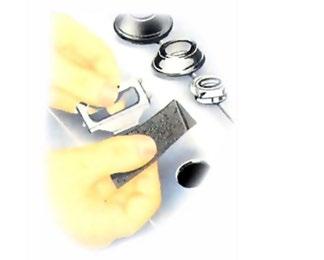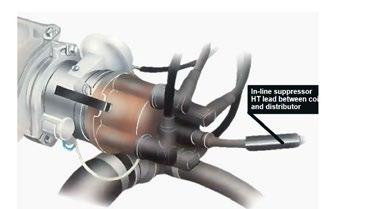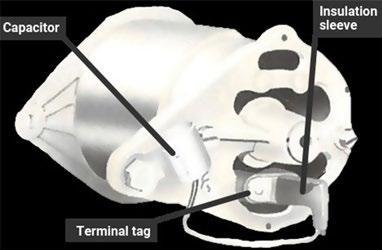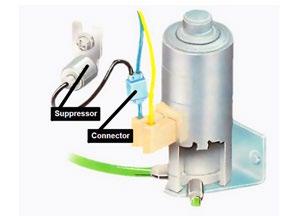
8 minute read
Technical - Noise Suppressors
At a recent gathering of club members, I was asked the reason for an electrical device connected to the back of the voltage condition meter fitted in a XJ series 2 Jaguar. At the time the voltage meter was not working and this was thought to be the possible cause.
Background:
Following the introduction of the Wireless Telegraphy Bill (1948) manufacturers were encouraged to develop and incorporate suppression type capacitors. Interference is caused by any piece of equipment employing commutator type motors or where the power supply to the equipment is suddenly interrupted. Examples of this type of equipment fitted to Jaguars are: Generators, alternators, windscreen wiper motors fuel pumps, electric radio antenna, heater motors, voltage regulators, electric window motors. Interference may be radiated by the equipment or its associated wiring. Interference caused by the equipment can be readily suppressed by fitting a suitable capacitor. The electrical system of older motor vehicles is unfiltered and the 12V DC power can be termed to be” dirty power” With the installation of audio equipment the need for suppression of interference to radio receivers, tape players, amplifiers became increasingly important. The original radio fitted to early jaguars needed it for AM stations. The more common type of capacitor used by jaguar is the Dubilier Type SV 1 and SV2 0.5 and 1microFarad (mfd.) 150V DC WKG respectively. The photo on the left shows a voltage regulator and suppression capacitor for the 10V DC power supply to the instruments. The Dubilier Type SV2 is fitted to the primary windings of the ignition coil and used to filter ignition noise out of the radio. For the High Tension (HT) resistance plug wires are used. The spark plugs recommended for the engine were Champion N 12Y there was no “R” as in RN12YC. These type of spark plugs have a semiconductor fitted.
The following is an extract on how to eliminate possible interference:
Car radio interference originates usually in the ignition system, the charging circuit or among electrical accessories. There are several checks you can carry out to trace the Source of the interference Interference is either radiated, that is, picked up by the aerial or conducted to the radio by its own wiring. Before looking for the source, make sure that the set itself is properly earthed to the car’s metal bodywork. Examine the aerial mounting it must have clean, firm contact with the underside of the bodywork to provide a satisfactory earth connection. Some interference is fairly easy to identify. A rapid crackling, or a ticking noise, that intensifies with engine speed and almost certainly is conducted, from the ignition system is the most common source of interference. The crackling usually originates from the high-tension (HT) side and the ticking from the low-tension (LT) parts. An alternator or dynamo not fitted with a suppressor will produce a whining sound, rising in pitch as the engine speed increases. Interference from electrical components such as windscreen wipers, fan heater and direction indicators can be identified immediately. The noise will disappear when the component is switched off. Conducted interference can be caused by the power supply cable or wiring to the speakers passing too close to the magnetic field of electrical components. Try re-routing the cable or speaker wiring as a preliminary step. If that solves the problem, secure the wires in their new position with plastic clips or wide adhesive tape. The car’s metal body acts as a screen between the aerial and the ignition and charging systems, so keep the bonnet closed whenever you listen to check interference.
Checking an aerial
Clean the metal parts of the aerial mounting with emery paper. The position of the aerial mast and the route of the lead greatly help to achieve interference-free reception. Fix the aerial as far away from the engine as possible. If it has to be near the engine, find a position farthest from the ignition system. Do not run the aerial lead through the engine compartment. It will almost certainly attract interference. Similarly, keep it well away from any wiring and electrical accessories. But also keep the lead short, so that it collects as few electrical emission’s as possible. Check that the aerial is properly earthed. Tune your radio into a weak station and grasp the aerial firmly while standing outside the car. If the radio becomes louder, the earthing may be faulty. To rectify, dismantle the mounting which usually has serrations or spikes penetrating the car body. Clean the metal with abrasive paper at the points of contact. Reassemble and tighten.
Suppressing a generator / Alternator
This Lucas ACR alternator has the capacitor fitted between the warning-lamp terminal and earth. Never connect a capacitor to an alternator field terminal. The generator can be suppressed by fitting a 1-3 mfd capacitor or a 3 mfd capacitor for an alternator. Connect the capacitor lead to the output terminal of the generator or alternator. With an alternator, remove the rear cover to reach the terminal. Follow the manufacturer’s recommendations carefully, as the device is easily damaged.
Generator
The capacitor is fitted to one of the mounting bolts and the connection made to the large terminal on the generator. Slacken the nearest generator securing bolt and clean the area with emery cloth to ensure a good earth. Slip the capacitor forked mounting tag under the bolt, and retighten. If interference from the charging circuit continues, check that the generator has a good earth.
Fitting a suppressor to the coil Single-lead suppressor for AM interference.
The basic suppressor for the ignition system is a 1 mfd suppressor. Attach it to the LT (+) terminal of the coil. If the trouble persists, try a 3 mfd capacitor for the AM set or a 2.5 mfd for the FM set. Finally, fasten an earth-bonding strap between the coil and chassis. All interference from the LT side of the ignition system should be eliminated
Curing HT interference
The violent crackling of HT interference is more difficult

to cure. First, check that the set and aerial are both properly earthed. Examine the condition of ignition components such as the plugs, points and, in particular, the HT leads, and sparkplug caps. Defective HT leads and plug connectors will create interference. Modern carbon-cored leads have built-in suppression. Renew
them if they are damaged or stretched.


The copper-cored type - which many radio enthusiasts prefer should have a suppressor built into the sparkplug cap. Check that the distributor has a coil-lead suppressor. Usually it is just above the sprung carbon brush in the cap. Most cars have this basic suppressor built into the distributor if your distributor does not have a suppressor, fit a 5K Ohm or 10K Ohm resistor in the coil lead to the distributor. There are two types of resistor - an in-line type which you connect to the middle of the HT lead, or a plug-in type which you push into the centre coil-lead socket in the distributor cap. If the interference continues, fit a similar suppressor to each
plug lead

Take care that the combined resistance of HT suppressors in the coil lead, distributor plug leads and plug caps does not exceed 25K Ohm. Otherwise, ignition power could be reduced.
Suppressing electric motors / Wiper motor

This Lucas permanent-magnet wiper motor is fitted with the maker’s ‘choke’ assembly. Every electric motor in the car generates its own magnetic field, which can radiate interference unless it is suppressed. Each motor is normally earthed through its mounting. With age, however mounting deteriorate, and flakes of paint or rust can act as an insulator between the mounting and car body.
Heater motor
This illustration shows chokes in series with feed wires and suppressors between each feed and earth. There are two ways to suppress interference from motors. First, try fitting an earth-bonding strap between the motor casing and the bodywork. Use a length of copper braiding, or a piece of heavy-gauge wire.
Electric clock
Suppressor and power-supply choke fitted to an electric clock. Scrape the points of contact to the bare metal to ensure good electrical connections, and secure the screw fixings tightly. If interference persists, connect a suppressor - 1 mfd or 2 mfd capacitor - between the motor feed wire and earth. This method is sustainable for both AM and FM radios.


A capacitor is fitted between the washer motor supply terminal and earth. If an electric motor continues to cause interference despite the fitting of suppressors, use a power supply choke, available from car-accessory stores. A choke is used in place of a series resistor because the choke allows better filtering (less residual AC ripple on the supply.
Finding other sources of interference
Interference can also be radiated by a metal part of the car

insulated from the main body.

Searching for FM body interference. The bonnet and boot lid, bumpers, rear axle and suspension units are among possible sources. Some electronic devices may also cause interference. The more that are fitted or added, the greater the chance that one is interfering with another, producing a humming background noise. There are two ways to locate the source, both requiring special devices. For an AM radio, use an aerial extension lead with a metal rod attached. Plug the lead into the set, start the engine and turn on the radio. Do not open the bonnet. Probe underneath and all around the car with the metal rod to find where the interference is strongest. Earth that part to the body with a bonding strap. For an FM radio, use a metal plate with a long earth lead bolted to it. Secure the other end of the lead tightly to bare chassis metal under a convenient nut or bolt. Start the engine and turn on the radio. Do not open the bonnet. Hold the plate with a pair of insulated pliers and move it underneath and all around the car. The plate acts as an interference reflector.










